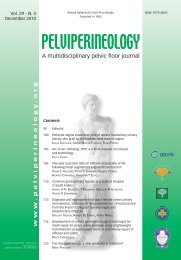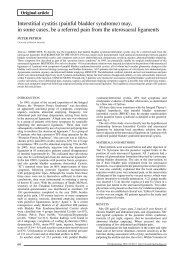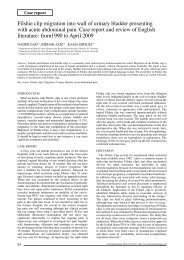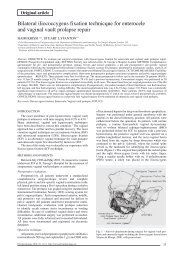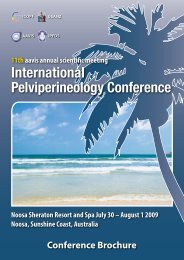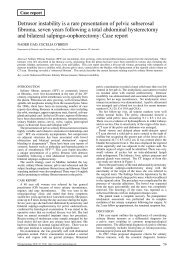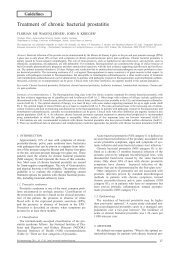a case report - Pelviperineology
a case report - Pelviperineology
a case report - Pelviperineology
Create successful ePaper yourself
Turn your PDF publications into a flip-book with our unique Google optimized e-Paper software.
Case Report<br />
Cure of haemorrhoids following a TFS posterior sling<br />
and TFS perineal body repair - a <strong>case</strong> <strong>report</strong><br />
GIANCARLO PARADISI (1) , PETER PETROS (2)<br />
(1)<br />
Department of Obstetrics and Gynecology, Università Cattolica del Sacro Cuore, Rome, Italy,<br />
(2)<br />
University of Western Australia<br />
Summary: Cure of 3rd degree prolapse, cystocele, rectocele and a bleeding haemorrhoids is <strong>report</strong>ed following total pelvic floor reconstruction<br />
with TFS tensioned minisling surgery.<br />
This <strong>case</strong> illustrates the importance of a holistic approach to pelvic organ disorders, repairing the organ’s structural components, rather than<br />
traumatic excision of organ parts<br />
CASE REPORT<br />
Mrs FA, aged 43 years, para3, BMI 22, presented with a<br />
feeling of heaviness, a uterus extruding from the vagina, and<br />
a history of haemorrhoids and bleeding for several years.<br />
She had regular periods with slight menstrual loss, normal<br />
ovaries, uterus and endometrium on ultrasound examination.<br />
There was no history or symptom of urinary dysfunction.<br />
Urodynamic testing indicated normal cystometry, normal<br />
urine flow, normal cough stress test at 400 ml, and a maximal<br />
urethral closure pressure of 156cm H2O.<br />
On clinical examination, prolapse according to the Baden<br />
Walker Score was Cystocele II°,<br />
Urethrocele II-III° with urethral hypermobility,<br />
Hysterocele III°, Rectocele I° with a thin bulging. POPQ<br />
Score (ICS) was : 3Aa, 3C, 1Bp<br />
Assessment of ligamentous damage with<br />
‘simulated operations’ in the OR<br />
Allis forceps applied 2cm superolaterally to the cervix,<br />
in the position of the cardinal ligaments and when<br />
approximated, restored the cystocele entirely, indicating<br />
that a cardinal ligament TFS would be sufficient.<br />
Application and approximation of Allis forceps to the<br />
vagina 2cm posterolateral to the cervix totally restored<br />
the uterine prolapse. The perineum was extremely lax,<br />
and the bulge created by digital stretching anteriorly was<br />
equivalent to a 3rd degree prolapse . Approximation of the<br />
laterally displaced perineal bodies significantly reduced the<br />
rectocele.<br />
Fig. 1. – The sites of TFS minisling reconstruction. This is a 3D view of the pelvic organs and ligaments from above and behind. The<br />
numbers signify which structures are supported by the TFS tapes. 1 TFS midurethral sling (pubourethral ligament); 2 TFS U-Sling (ATFP<br />
and pubocervical fascia); 3 TFS high cystocoele repair (cardinal ligament cervical ring); 4 TFS uterine prolapse/apical repair (uterosacral<br />
ligaments); 5 TFS perineal body repair (m.deep transversus perinei).<br />
62<br />
<strong>Pelviperineology</strong> 2010; 29: 62-63 http://www.pelviperineology.org
Case <strong>report</strong><br />
Surgery<br />
The uterine prolapse, cystocele and rectocele were<br />
repaired entirely by precise application of the TFS tapes<br />
in the position of the damaged ligaments, Nos 4,3&5, in<br />
fig1, without tissue excision, as described previously 1,2 . The<br />
surgical operations were all performed by the first author,<br />
some for the first time, with the assistance of the 2nd author.<br />
Total operating time including discussion, and ‘simulated<br />
operations’ to assess which ligaments were damaged was<br />
150 minutes. Total blood loss was 200ml. At the end of the<br />
operation, a deep normal axial restoration of anatomy was<br />
noted for the anterior vaginal wall, uterus, and posterior<br />
vaginal wall, with complete disappearance of cystocoele<br />
and rectocele. The postoperative changes to the perineal<br />
anatomy are self-evident, figs 2&3.<br />
DISCUSSION<br />
This <strong>case</strong> emphasizes the need for a holistic view of pelvic<br />
floor dysfunctions. We were able to cure the haemorrhoids<br />
as part of a total pelvic floor reconstruction. “‘restoration of<br />
form (structure) leads to restoration of function’.”- Integral<br />
Theory 3 . This <strong>case</strong> also sheds light on a wider issue, the<br />
futility of painful and sometimes hazardous excision of<br />
major segments of an organ, in this <strong>case</strong> rectum, when a<br />
minor, less damaging procedure not only is enough, but also<br />
restores other dysfunctions such as hemorrhoids.<br />
We attribute hemorrhoid cure to upward and backward<br />
stretching of the anterior wall of rectum by the posterior<br />
sling, a restoration which also eliminates the varicosities<br />
and venous return of rectal wall veins which we believe<br />
are the ultimate cause of hemorrhoid formation. Using pre<br />
Fig. 3 – Haemorrhoids post-operative. There was minimal pain,<br />
and the patient was discharged on the second post-operative day.<br />
and postoperative evacuating proctograms, Abenstein et al. 4<br />
demonstrated cure of anterior rectal wall intussusception with<br />
a posterior sling, but did not <strong>report</strong> cure of hemorrhoids..<br />
The concept of ‘simulated operations’ in effect brings<br />
together laterally displaced structures in real time. This<br />
manoeuvre diminishes the herniation, and restores muscle<br />
tension on the structures, allowing the surgeon to more<br />
accurately decide which structures to repair.<br />
REFERENCES<br />
1. Petros PEP, Chapter 4,Surgery,in “The female Pelvic Floor”,<br />
2nd Edition, Springer Heidelberg, 2006, pp 112-159.<br />
2. Petros PE Richardson PA. A 3 year follow-up review of uterine/<br />
vault prolapse repair using the TFS minisling, RANZJOG 2009;<br />
49; 4. 439-440 (2).<br />
3. Petros PEP, Chapter 1, Overview, in “The female Pelvic Floor”,<br />
2nd Edition, Springer Heidelberg, 2006, p 7.<br />
4. Abendstein B, Petros P. E. P, Richardson P. A., Goeschen K,<br />
Dodero D. The surgical anatomy of rectocele and anterior rectal<br />
wall intussusception. Int Urogynecol. J 2008; 19: 513-7.<br />
Fig. 2 – Haemorrhoids pre-operative.<br />
Correspondence to:<br />
Email addresses:<br />
giancarlo.paradisi@tin.it - kvinno@highway1.com.au<br />
Website: www.integraltheory.org<br />
63



